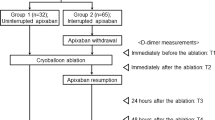Abstract
Introduction
In recent years, several novel anticoagulants have been approved for the prevention of thromboembolic strokes as an alternative to warfarin in patients with atrial arrhythmias. Studies have evaluated these medications in patients undergoing radiofrequency ablation, yet no data exists to evaluate the bleeding risk in patients undergoing cryoballoon ablation procedures.
Methods
Patients that underwent either cryoballoon ablation alone or with additional radiofrequency ablation over the past 3 years were included in the study. Patients were stratified into one of three subsets based on type of anticoagulation (warfarin, dabigatran, or rivaroxaban). Bleeding complications during the first 48 h and first 2 weeks following the ablation were recorded. Major complications were defined as hemorrhage requiring blood products or need for vascular intervention. Minor complications included prolonged bleeding from catheter insertion site, development of ecchymosis, or hematoma formation. Intraprocedural activated clotting times (ACT) were assessed and compared.
Results
A total of 217 patients met inclusion criteria of which 87 (40.1 %) patients were on warfarin, 90 (41.5 %) patients on dabigatran, and 40 (18.4 %) patients on rivaroxaban. The overall bleeding complication rate was 12.0 %. All complications occurred within the first 48 h post-ablation. Nine (10.3 %) complications occurred in the warfarin subset, ten (11.1 %) in the rivaroxaban subset, and seven (17.5 %) in the dabigatran subset (p = 0.49). The warfarin and dabigatran subsets had higher average ACT levels (424.9 versus 406.5) compared to the rivaroxaban subset (393.4; p < 0.01). Subanalyses found no difference in bleeding complications based on procedure type.
Conclusion
Bleeding complications post-ablation were similar for warfarin, dabigatran, and rivaroxaban in patients undergoing cryoballoon ablation. Compared with radiofrequency ablation, cryoablation does not place patients at an increased bleeding risk.

Similar content being viewed by others
References
Packer, D. L., Kowal, R. C., Wheelan, K. R., et al. (2013). Cryoballoon ablation of pulmonary veins for paroxysmal atrial fibrillation: first results of the North American Arctic Front (STOP AF) pivotal trial. Journal of the American College of Cardiology, 61(16), 1713–1723.
Tse, H. F., Reek, S., Timmermans, C., et al. (2013). Pulmonary vein isolation using transvenous catheter cryoablation for treatment of atrial fibrillation without risk of pulmonary vein stenosis. Journal of the American College of Cardiology, 42(4), 752–758.
Tayebjee, M. H., Hunter, R. J., Baker, V., et al. (2011). Pulmonary vein isolation with radiofrequency ablation followed by cryotherapy: a novel strategy to improve clinical outcomes following catheter ablation of paroxysmal atrial fibrillation. Europace, 13(9), 1250–1255.
Mansour, M., Forleo, G. B., Pappalardo, A., et al. (2010). Combined use of cryoballoon and focal open-irrigation radiofrequency ablation for treatment of persistent atrial fibrillation: results from a pilot study. Heart Rhythm, 7(4), 452–458.
Connolly, S. J., Ezekowitz, M. D., Yusuf, S., et al. (2009). Dabigatran versus warfarin in patients with atrial fibrillation. The New England Journal of Medicine, 361(12), 1139–1151.
Patel, M. R., Mahaffey, K. W., Garg, J., et al. (2011). Rivaroxaban versus warfarin in nonvalvular atrial fibrillation. The New England Journal of Medicine, 365(10), 883–891.
Snipelisky, D., Kauffman, C., Prussak, K., Johns, G., Venkatachalam, K., & Kusumoto, F. (2012). A comparison of bleeding complications post-ablation between warfarin and dabigatran. Journal of Interventional Cardiac Electrophysiology, 35(1), 29–33.
Lakkireddy, D., Reddy, Y. M., Di Biase, L., Vanga, S. R., et al. (2012). Feasibility and safety of dabigatran versus warfarin for periprocedural anticoagulation in patients undergoing radiofrequency ablation for atrial fibrillation: results from a multicenter prospective registry. Journal American College of Cardiology, 59(13), 1168–1174.
Winkle, R. A., Mead, R. H., Engel, G., Kong, M. H., & Patrawala, R. A. (2012). The use of dabigatran immediately after atrial fibrillation ablation. Journal of Cardiovascular Electrophysiology, 23(3), 264–268.
Eitel, C., Koch, J., Sommer, P., et al. (2013). Novel oral anticoagulants in a real-world cohort of patients undergoing catheter ablation of atrial fibrillation. Europace, 15(11), 1587–1593.
Snipelisky, D., & Kusumoto, F. (2013). Current strategies to minimize the bleeding risk of warfarin. Journal of Blood Medicine, 4, 89–99.
Spinler, S. A., & Shafir, V. (2012). New oral anticoagulants for atrial fibrillation. Circulation, 126(1), 133–137.
Knight, B. P. (2012). Anticoagulation for atrial fibrillation: what is the optimal strategy? Journal of the American College of Cardiology, 59(13), 1175–1177.
Baglin, T. (2013). Clinical use of new oral anticoagulant drugs: dabigatran and rivaroxaban. British Journal of Haematology, 163(2), 160–167.
Author information
Authors and Affiliations
Corresponding author
Rights and permissions
About this article
Cite this article
Snipelisky, D., Ray, J.C., Ung, R. et al. A comparison of bleeding complications between warfarin, dabigatran, and rivaroxaban in patients undergoing cryoballoon ablation. J Interv Card Electrophysiol 41, 231–236 (2014). https://doi.org/10.1007/s10840-014-9948-1
Received:
Accepted:
Published:
Issue Date:
DOI: https://doi.org/10.1007/s10840-014-9948-1




